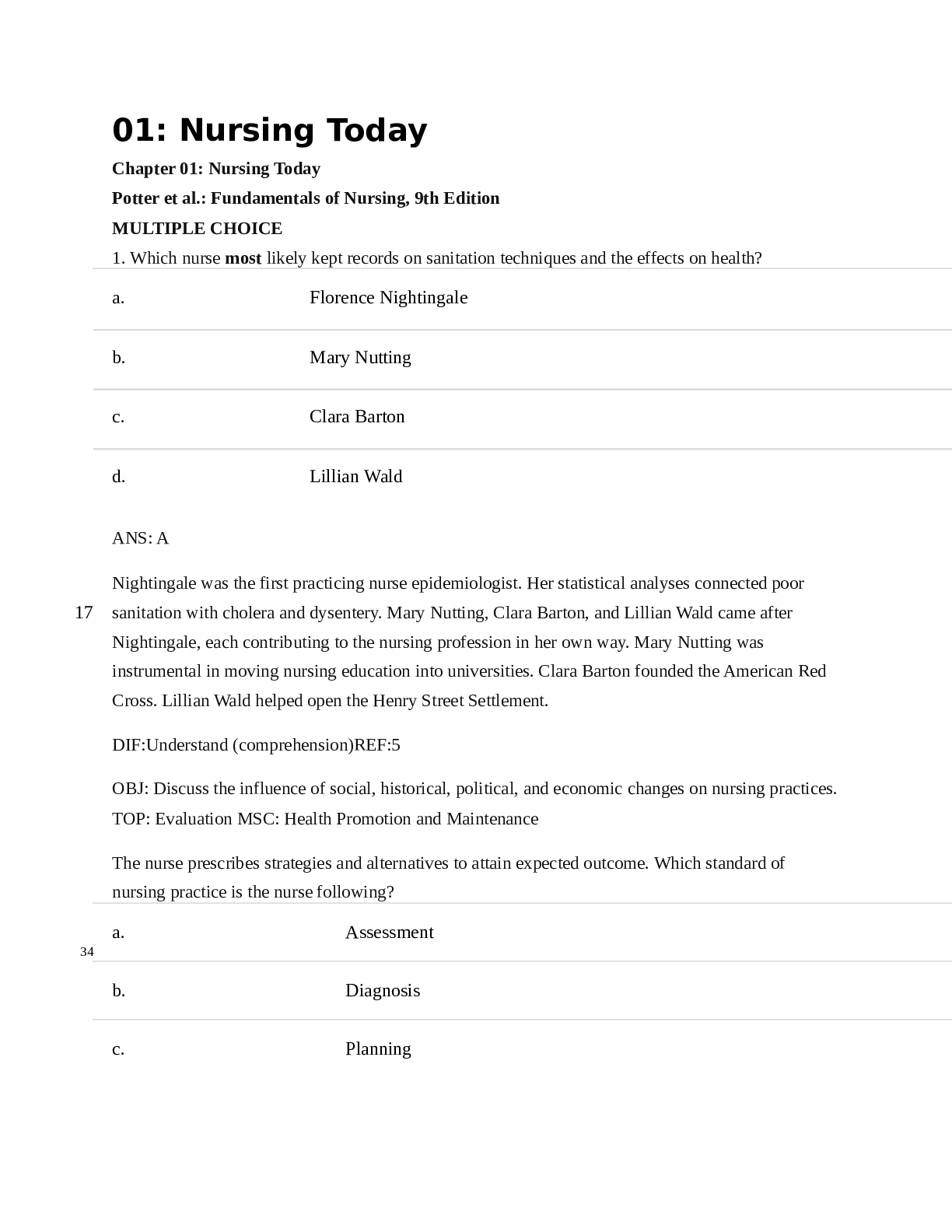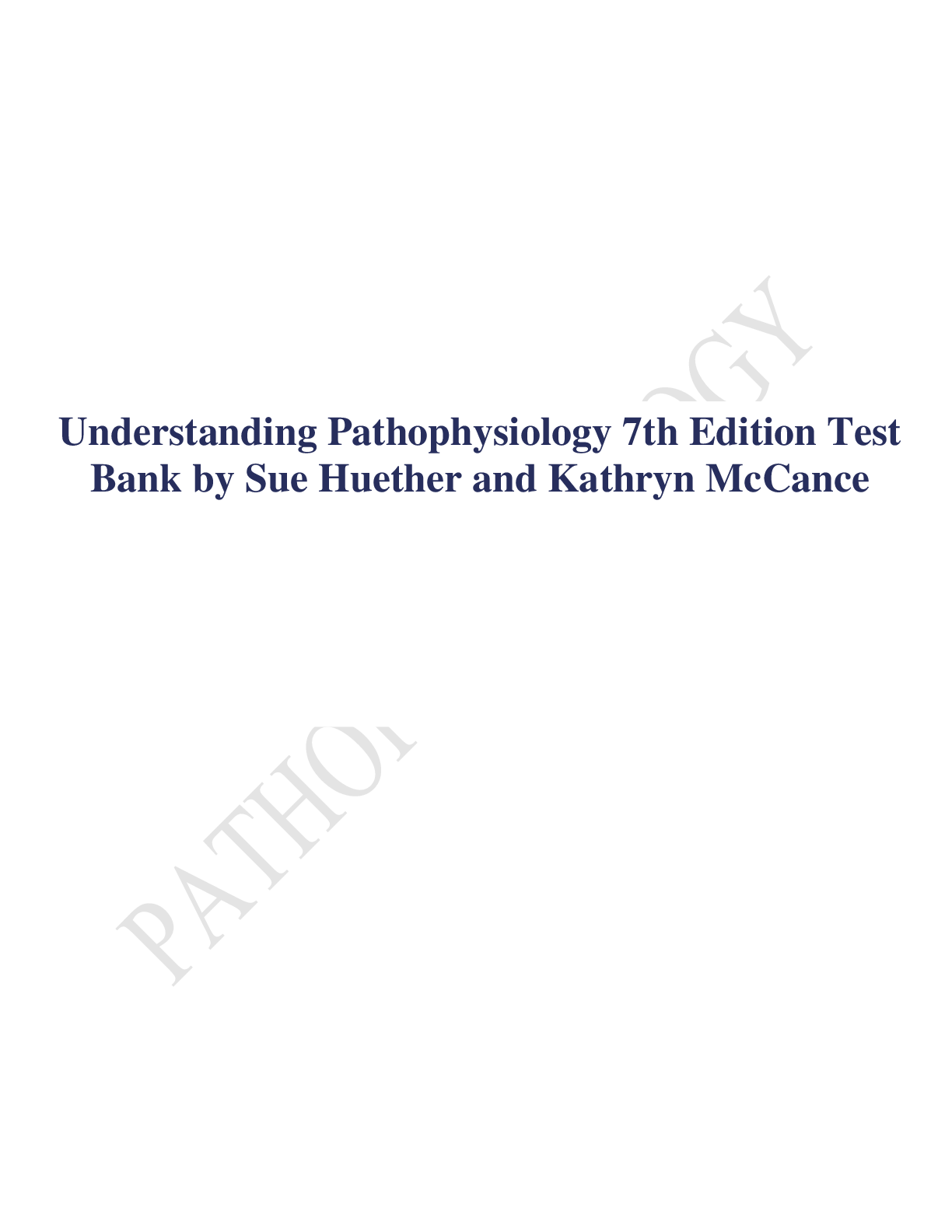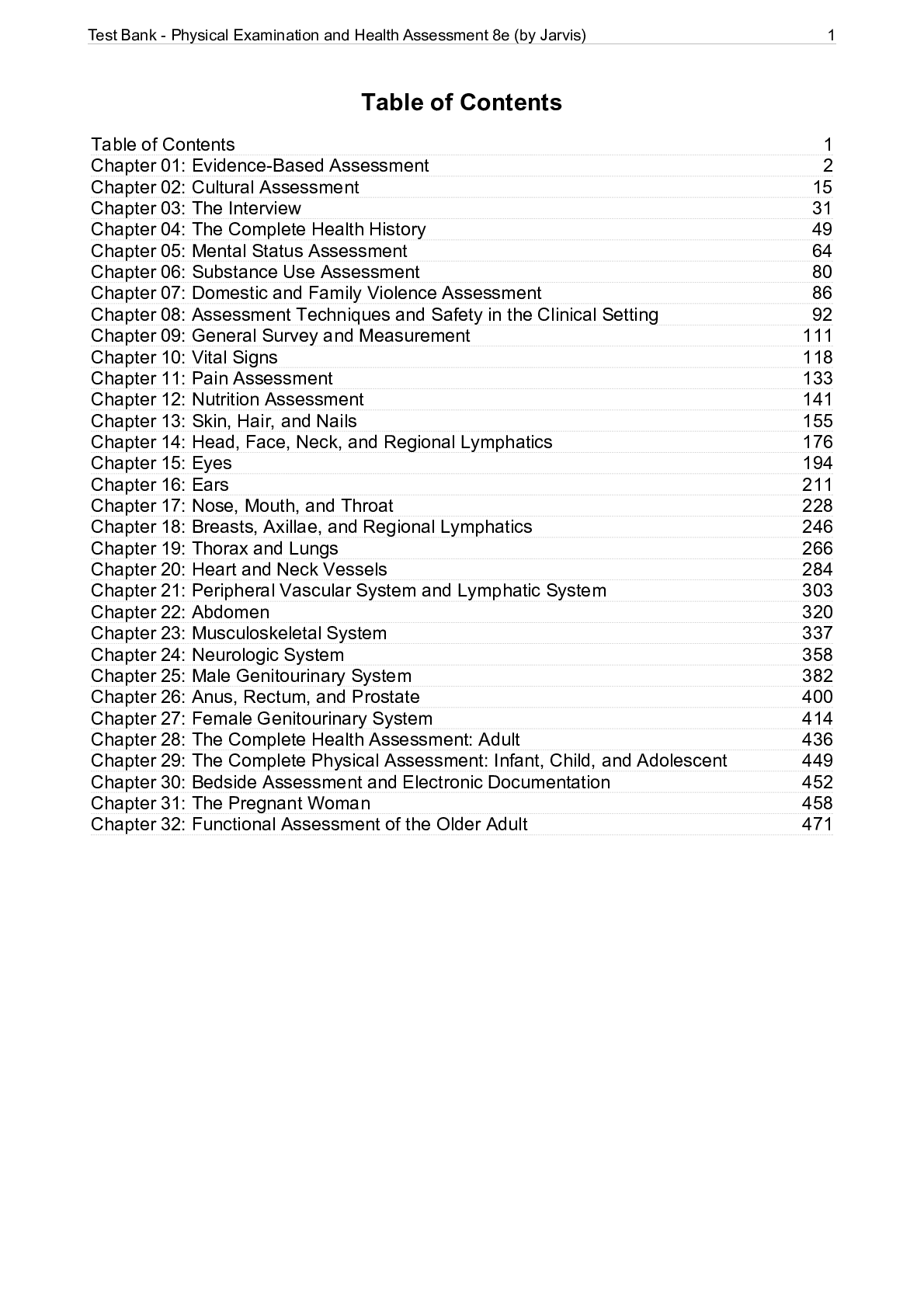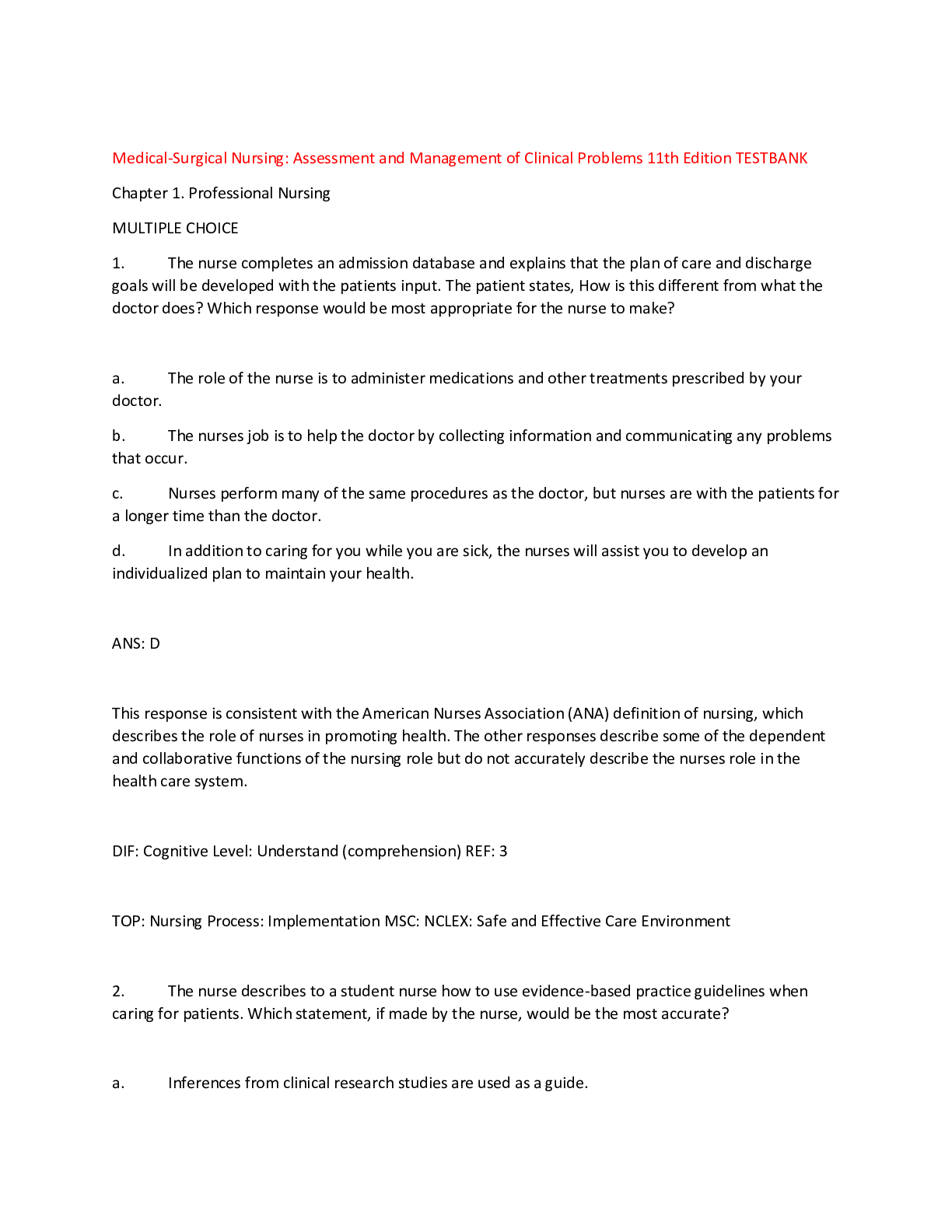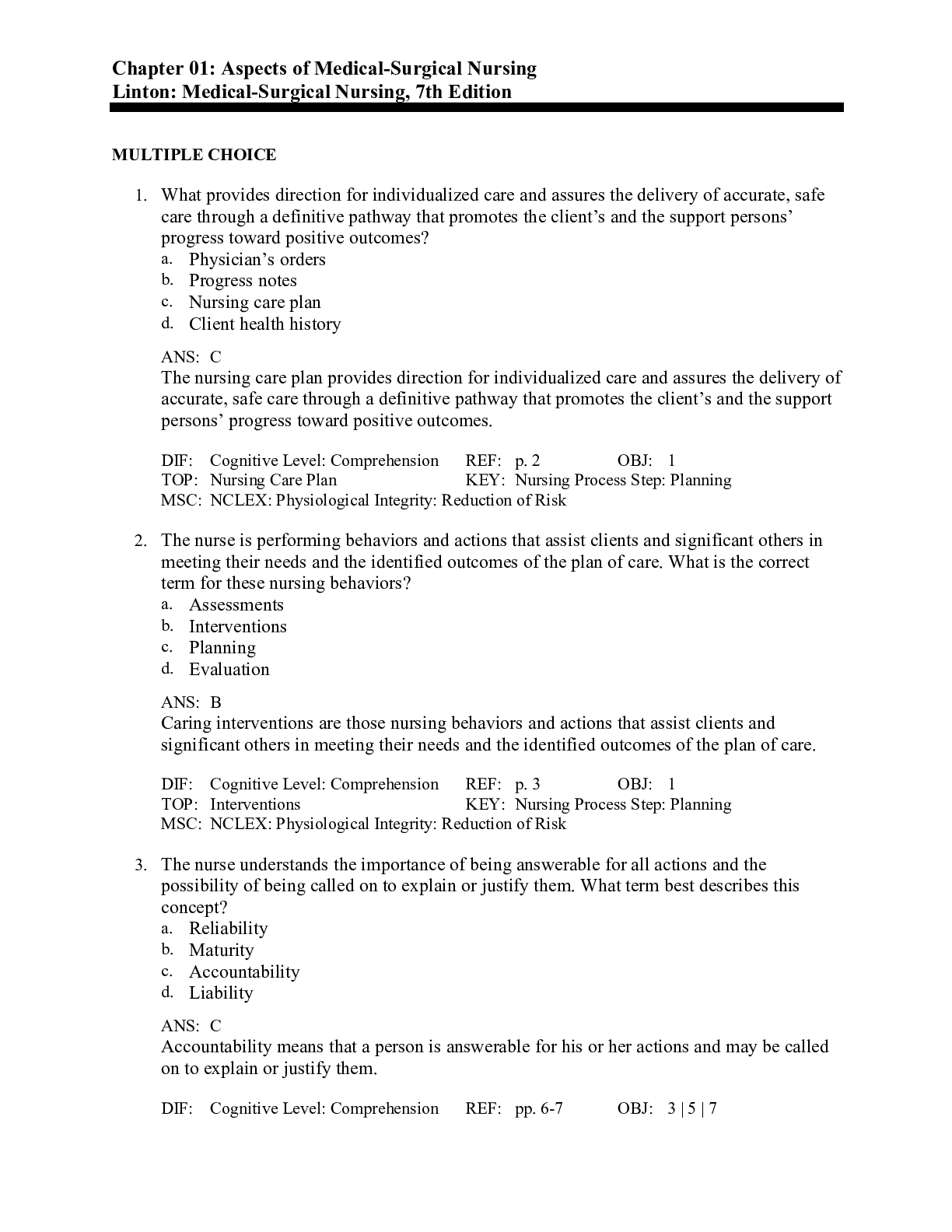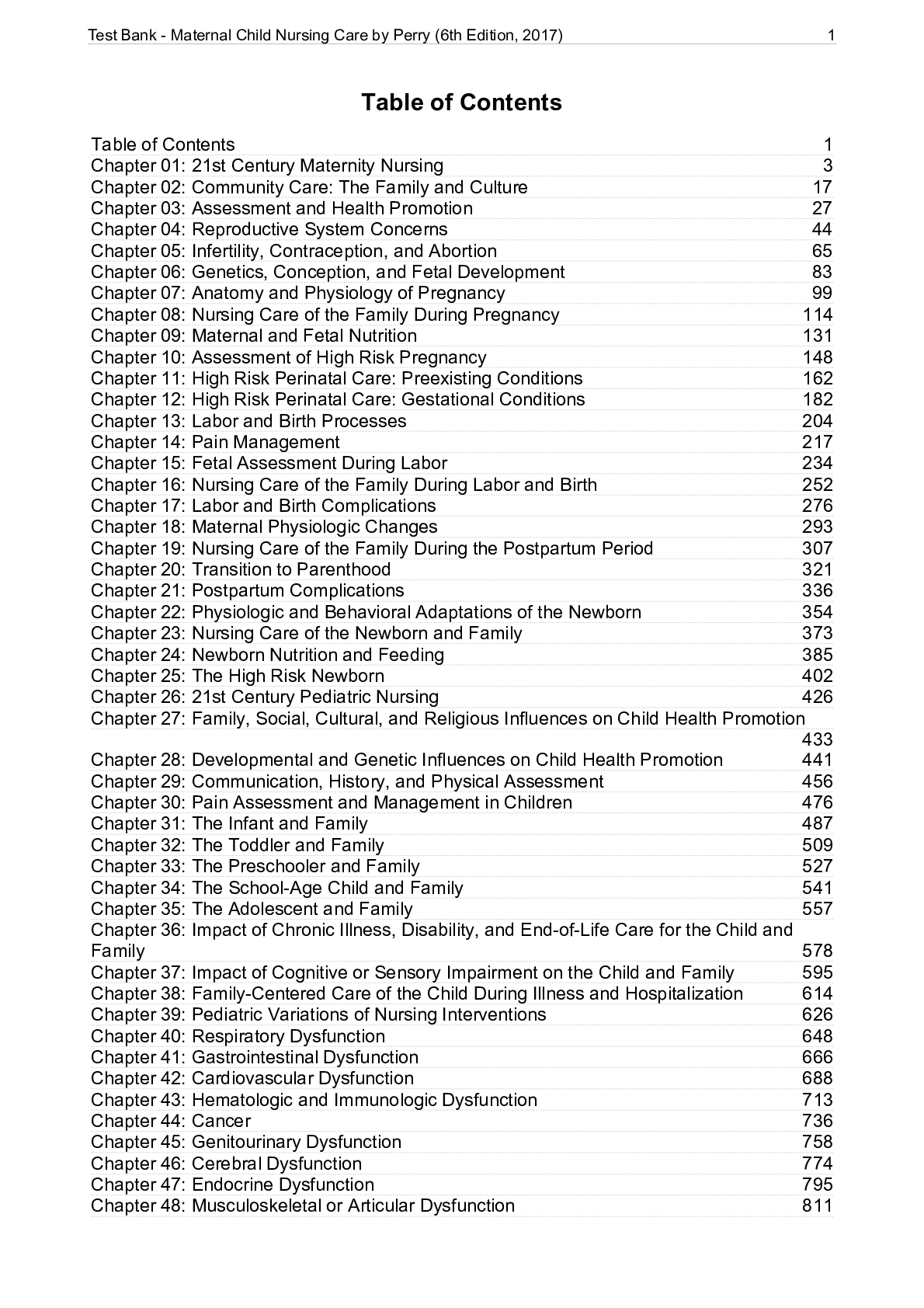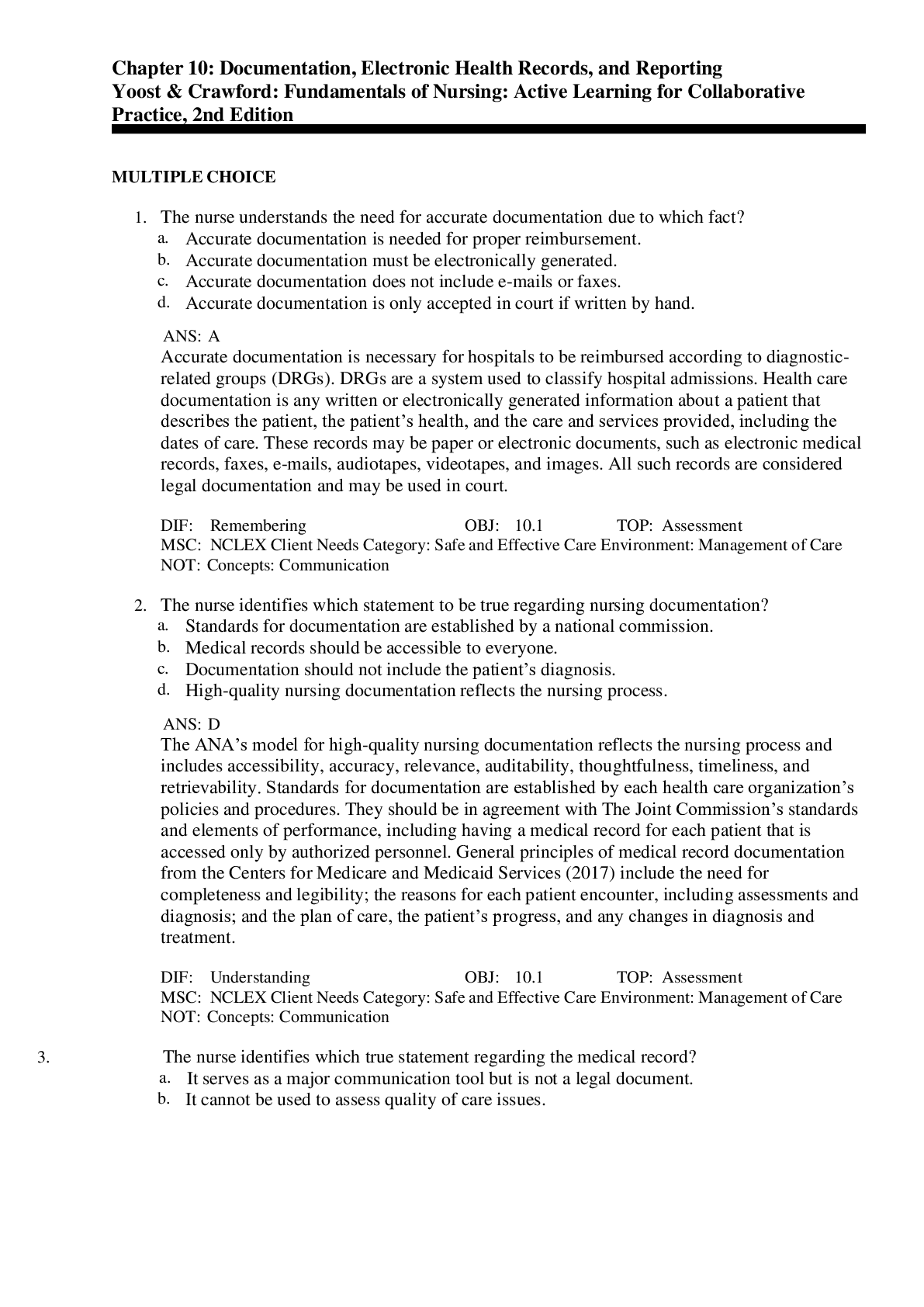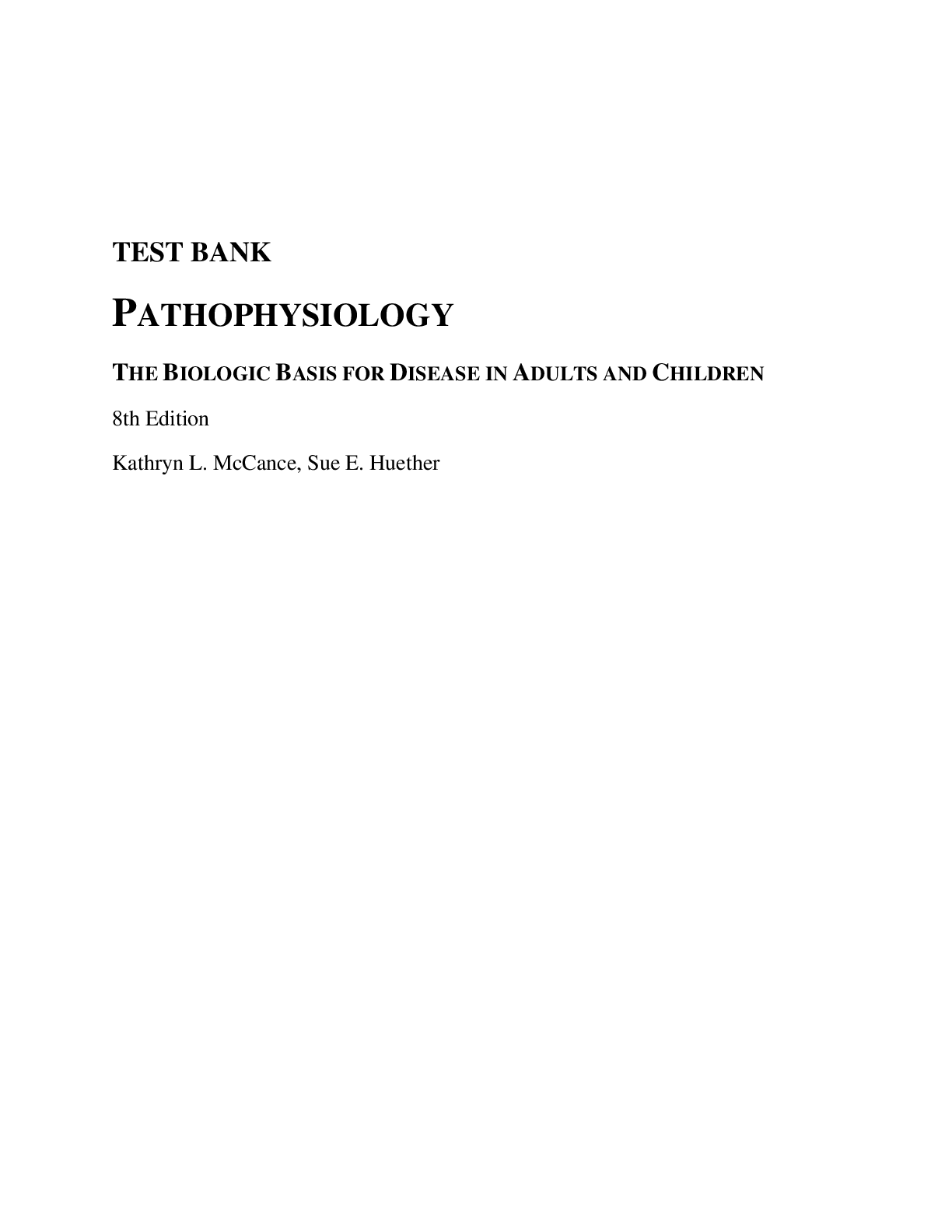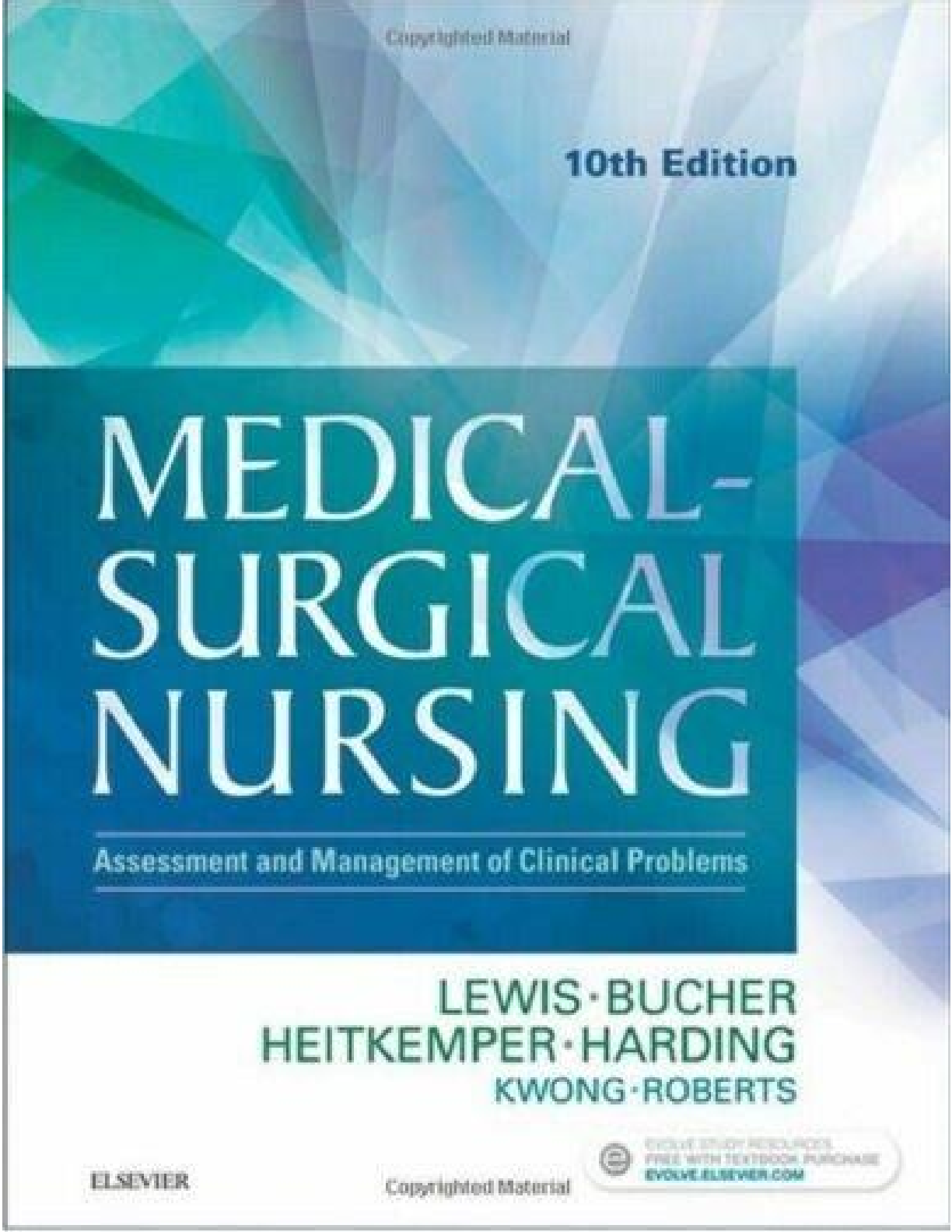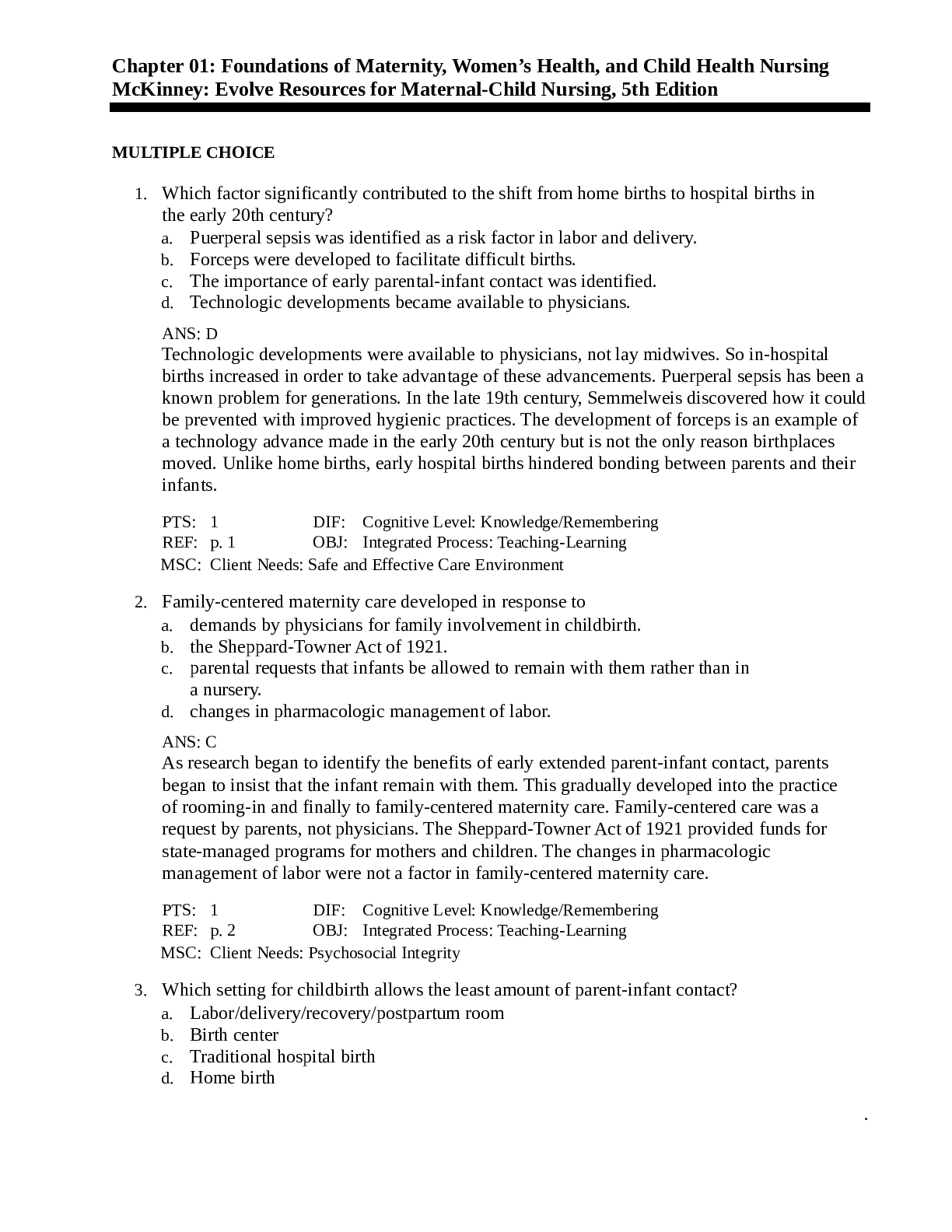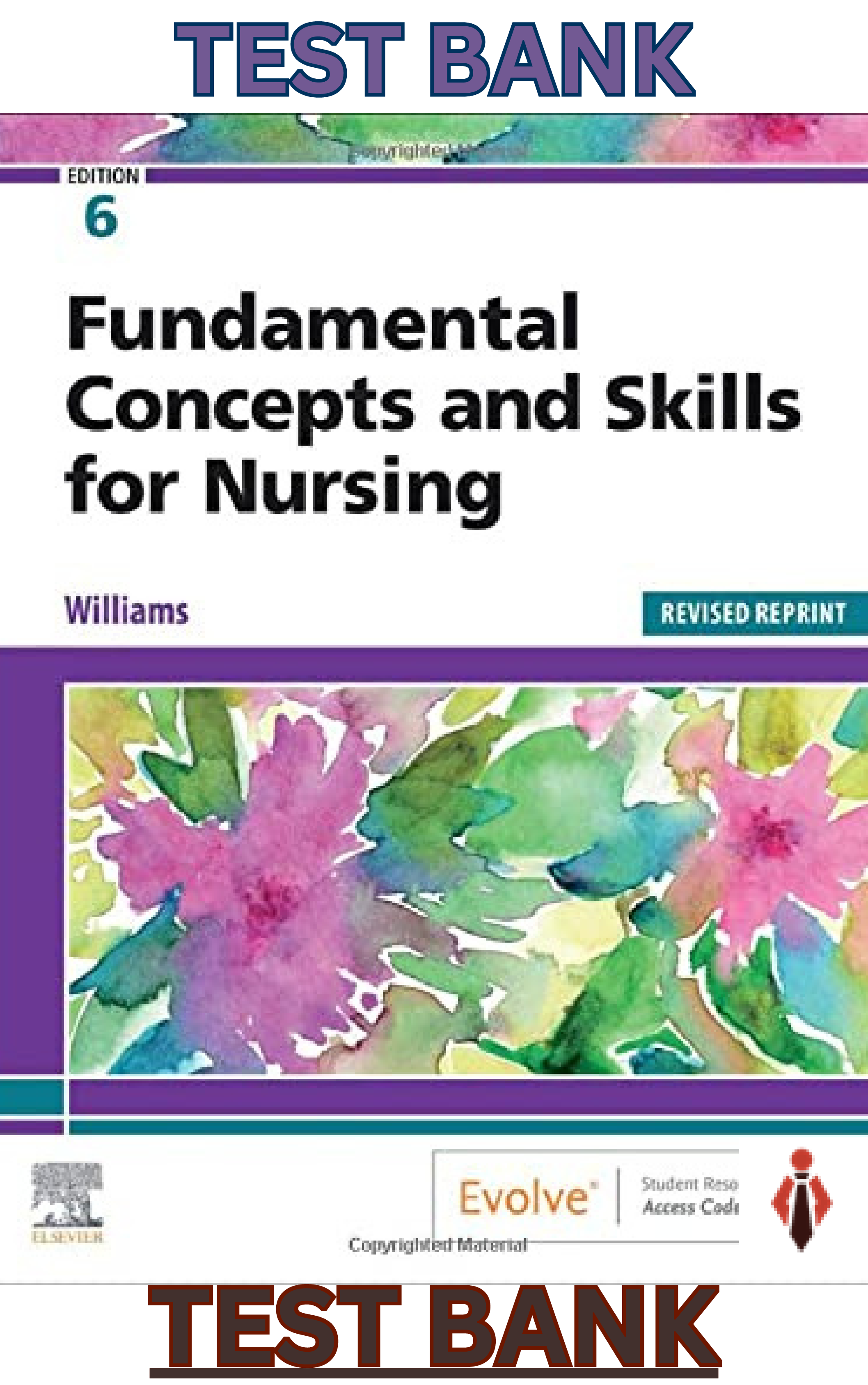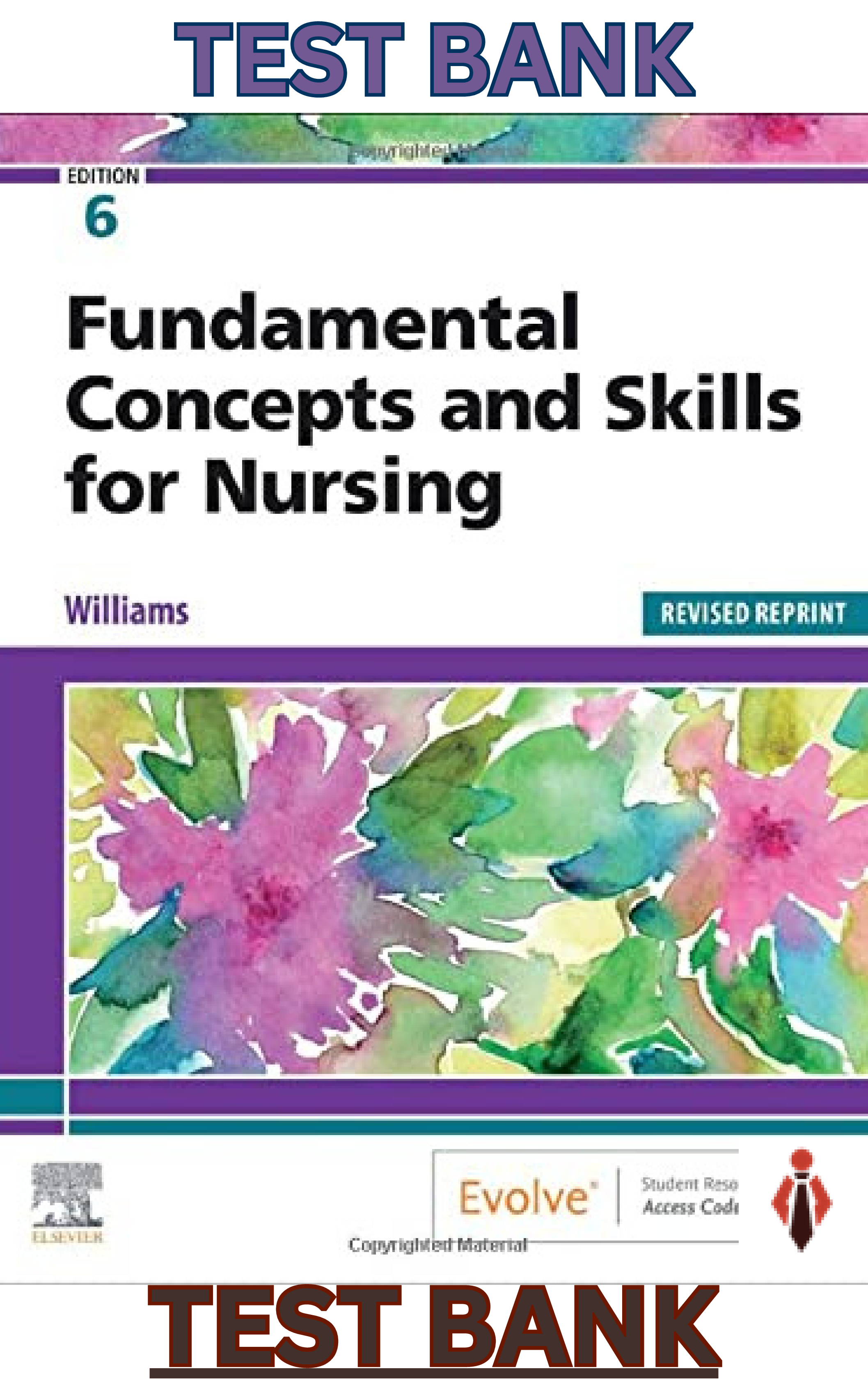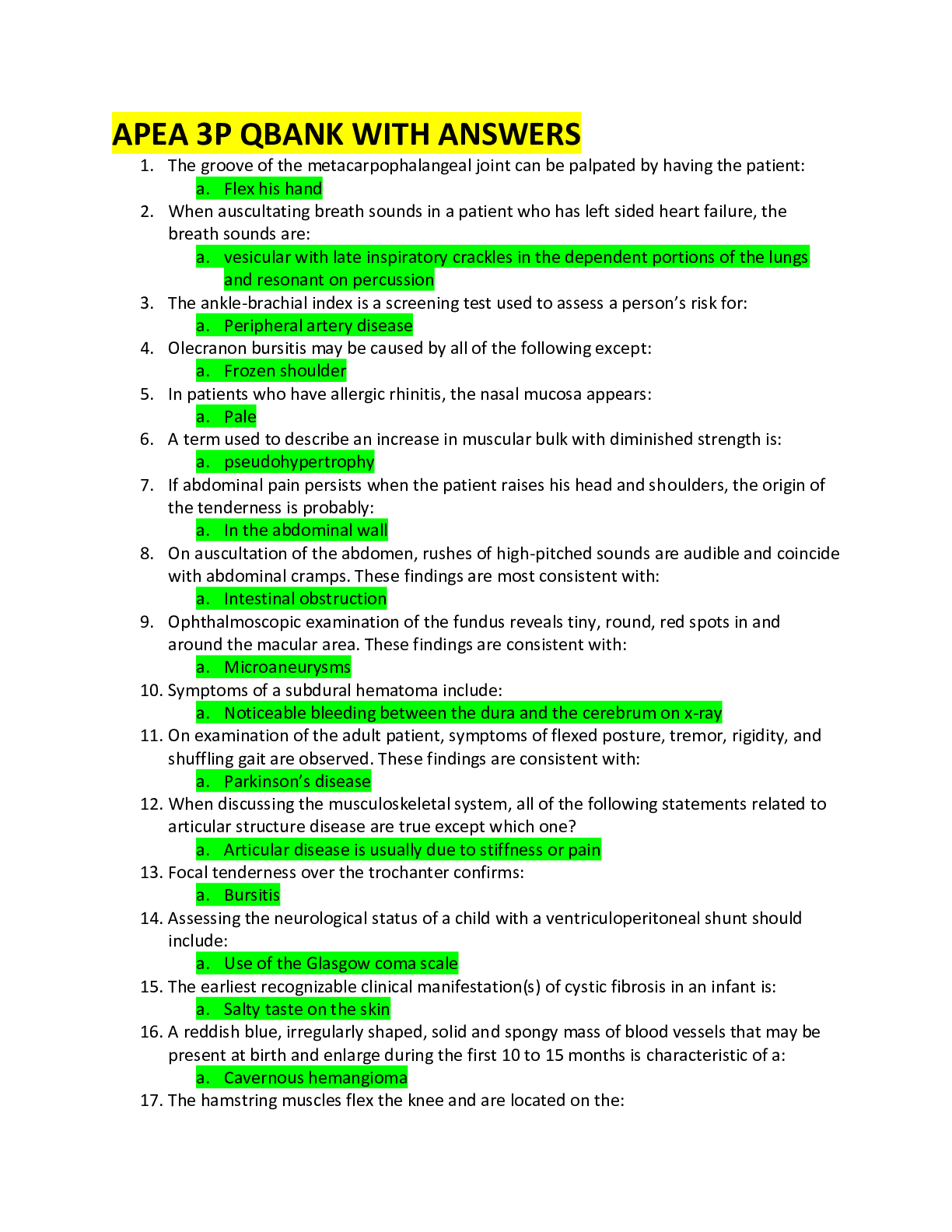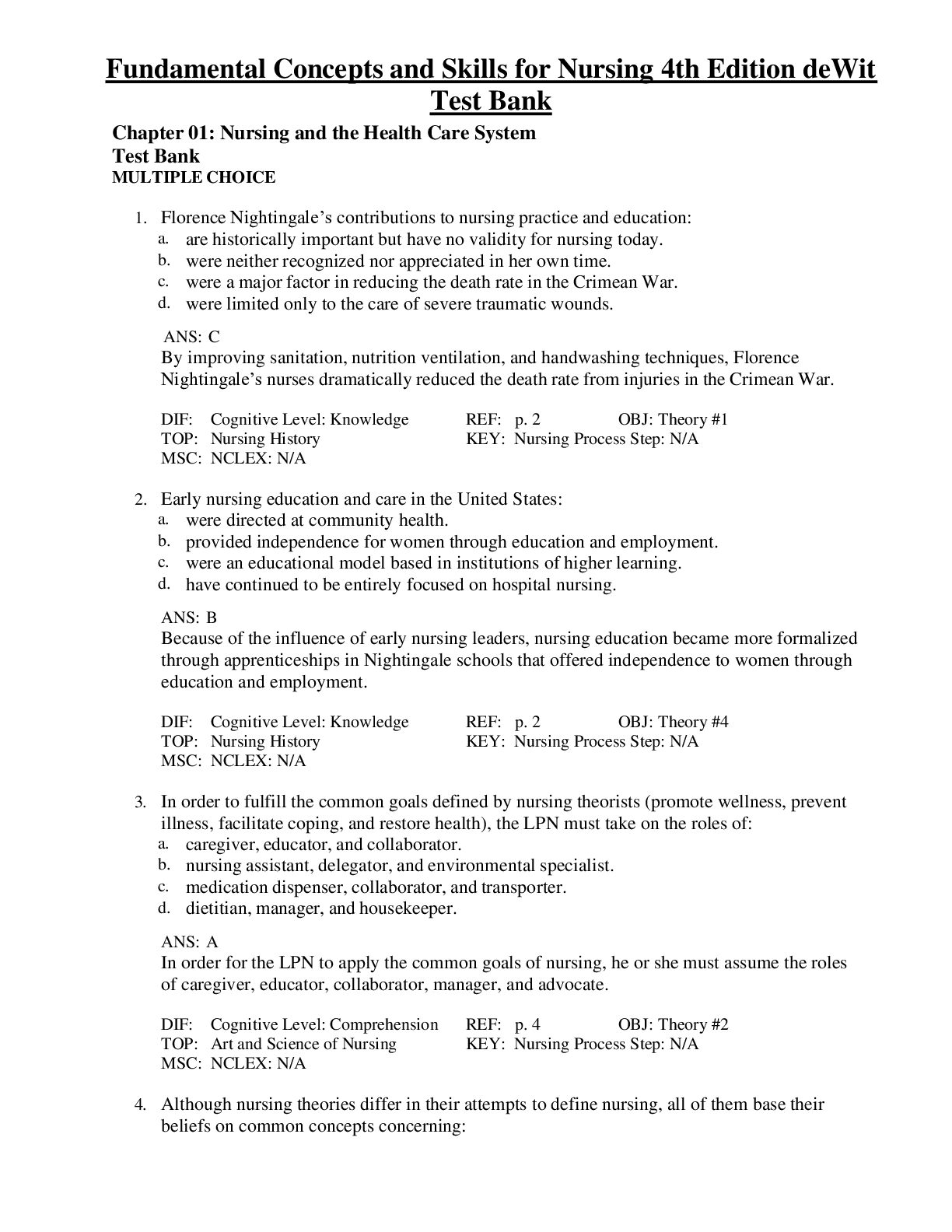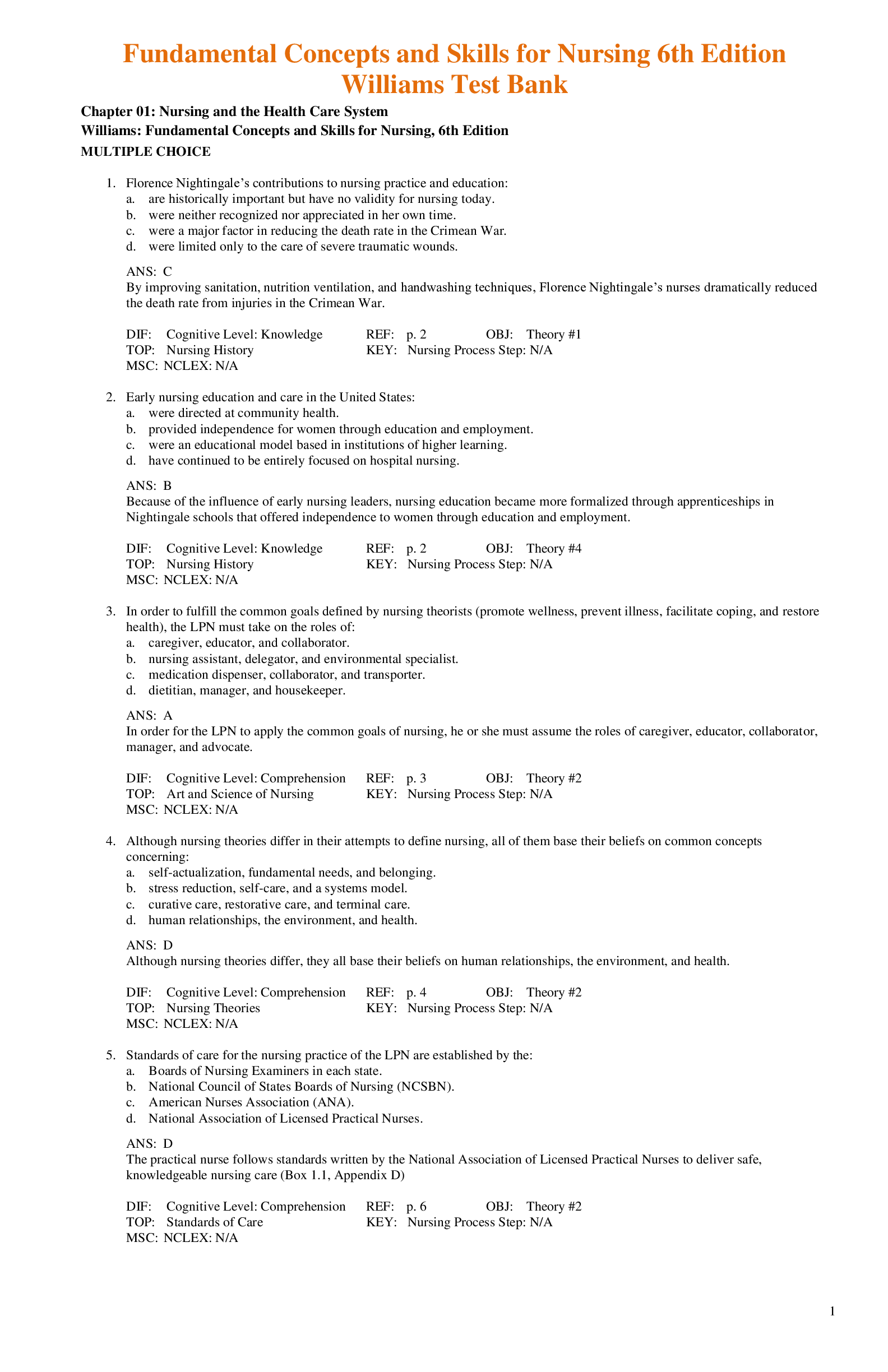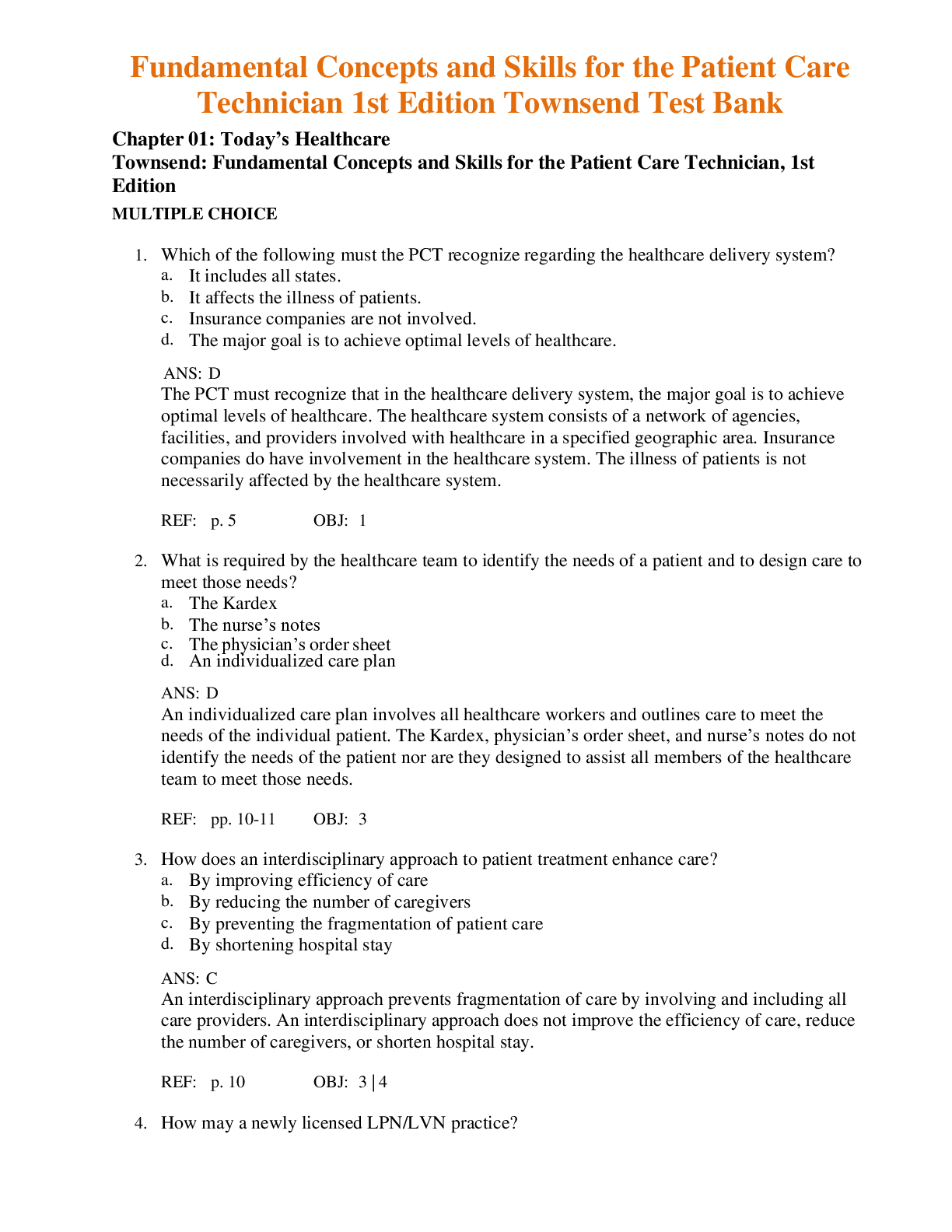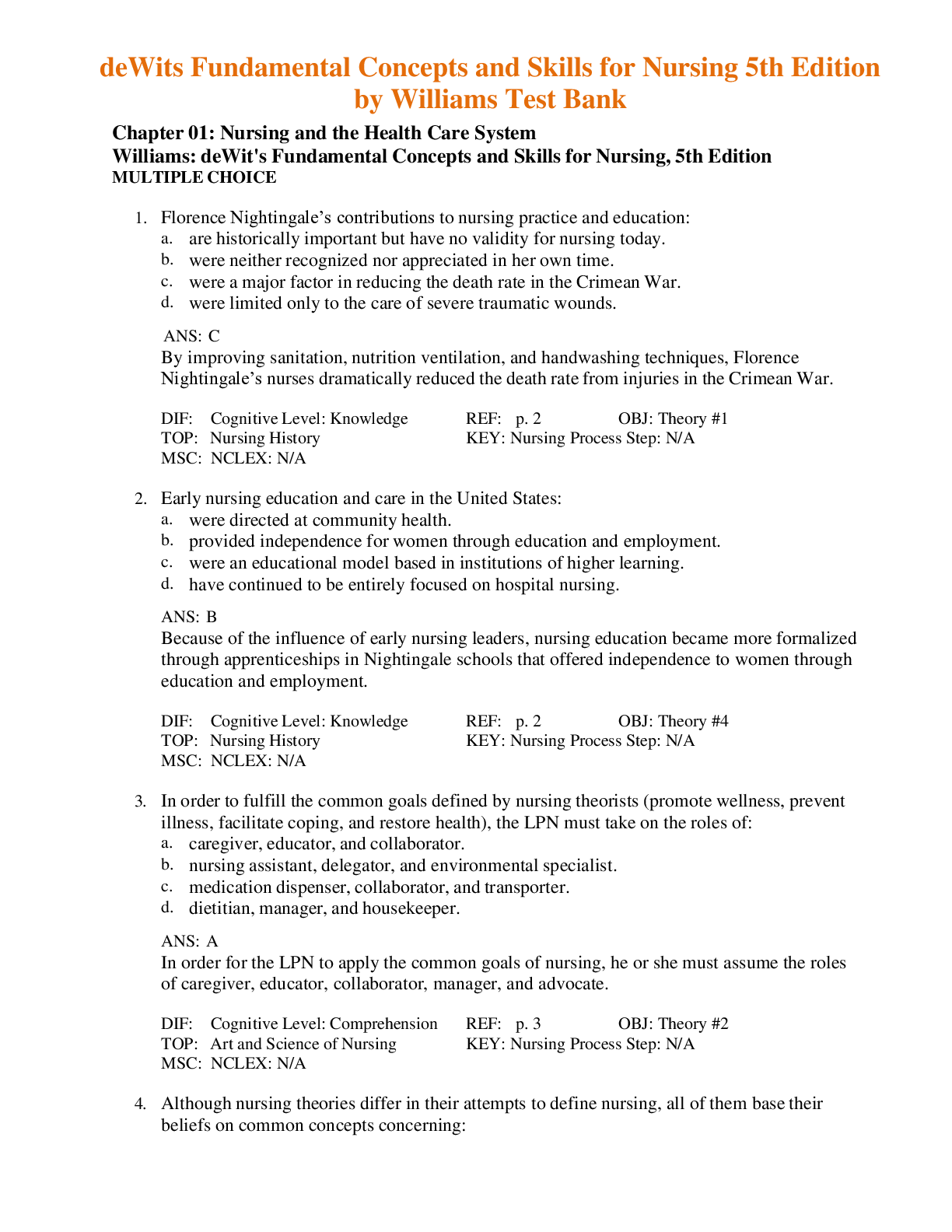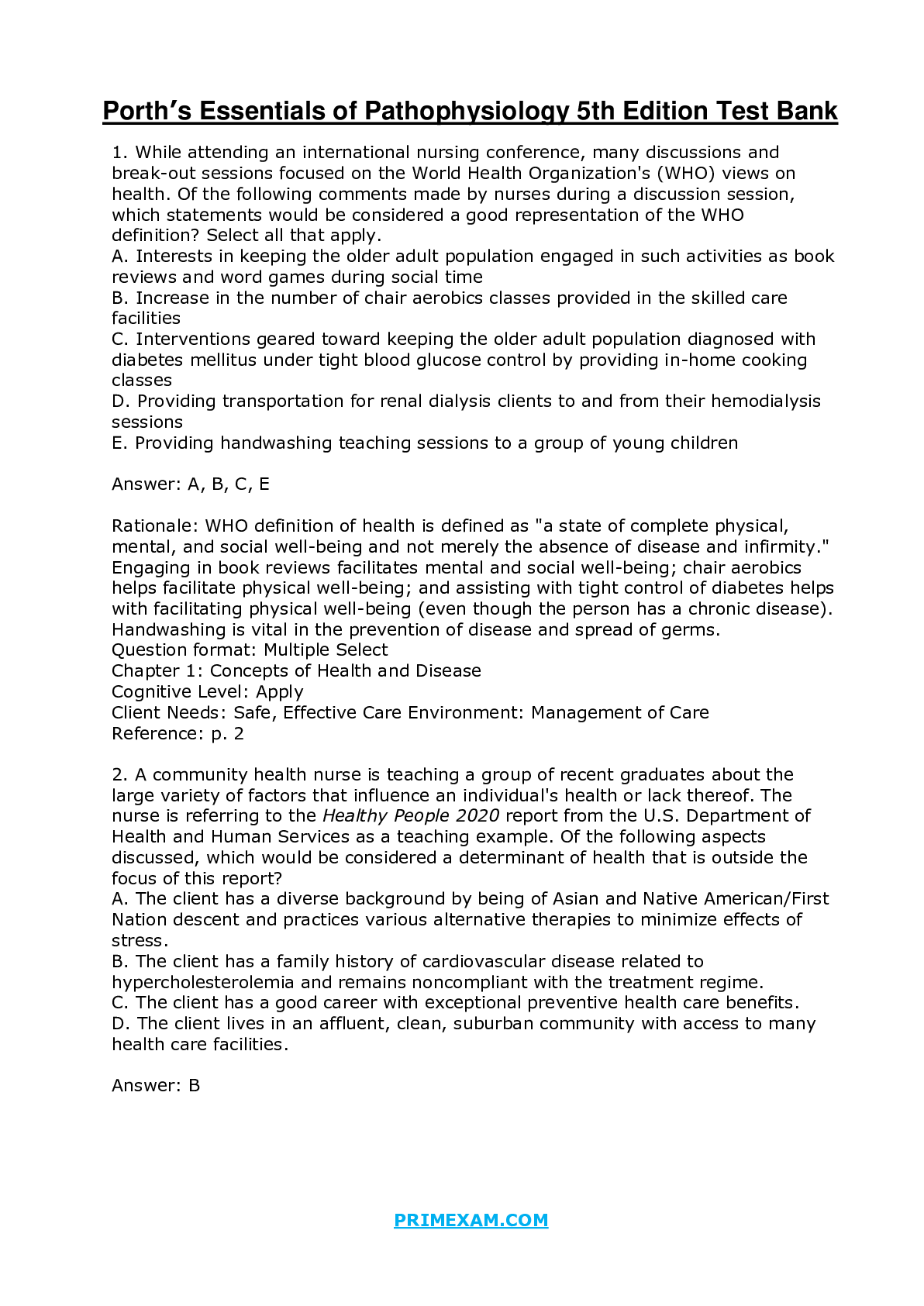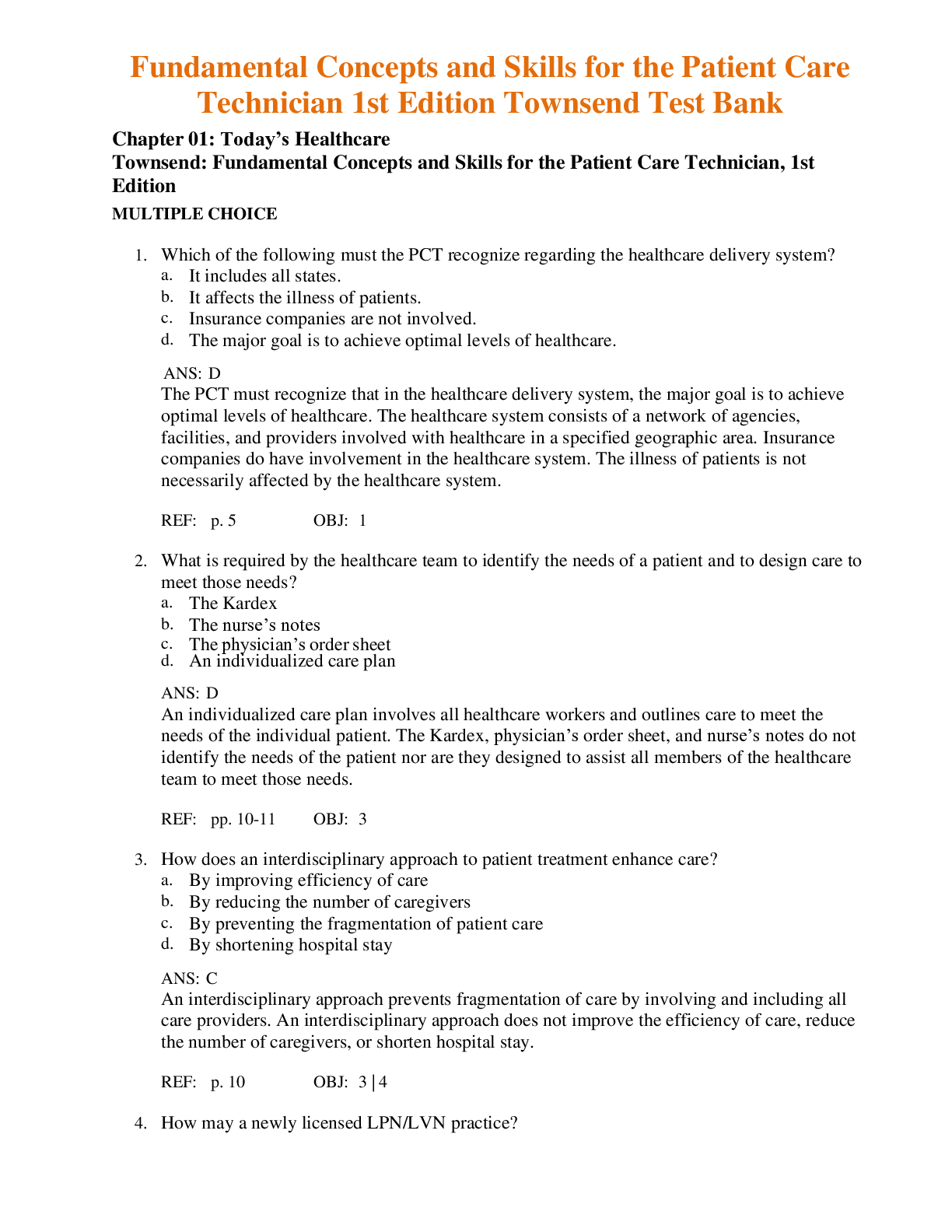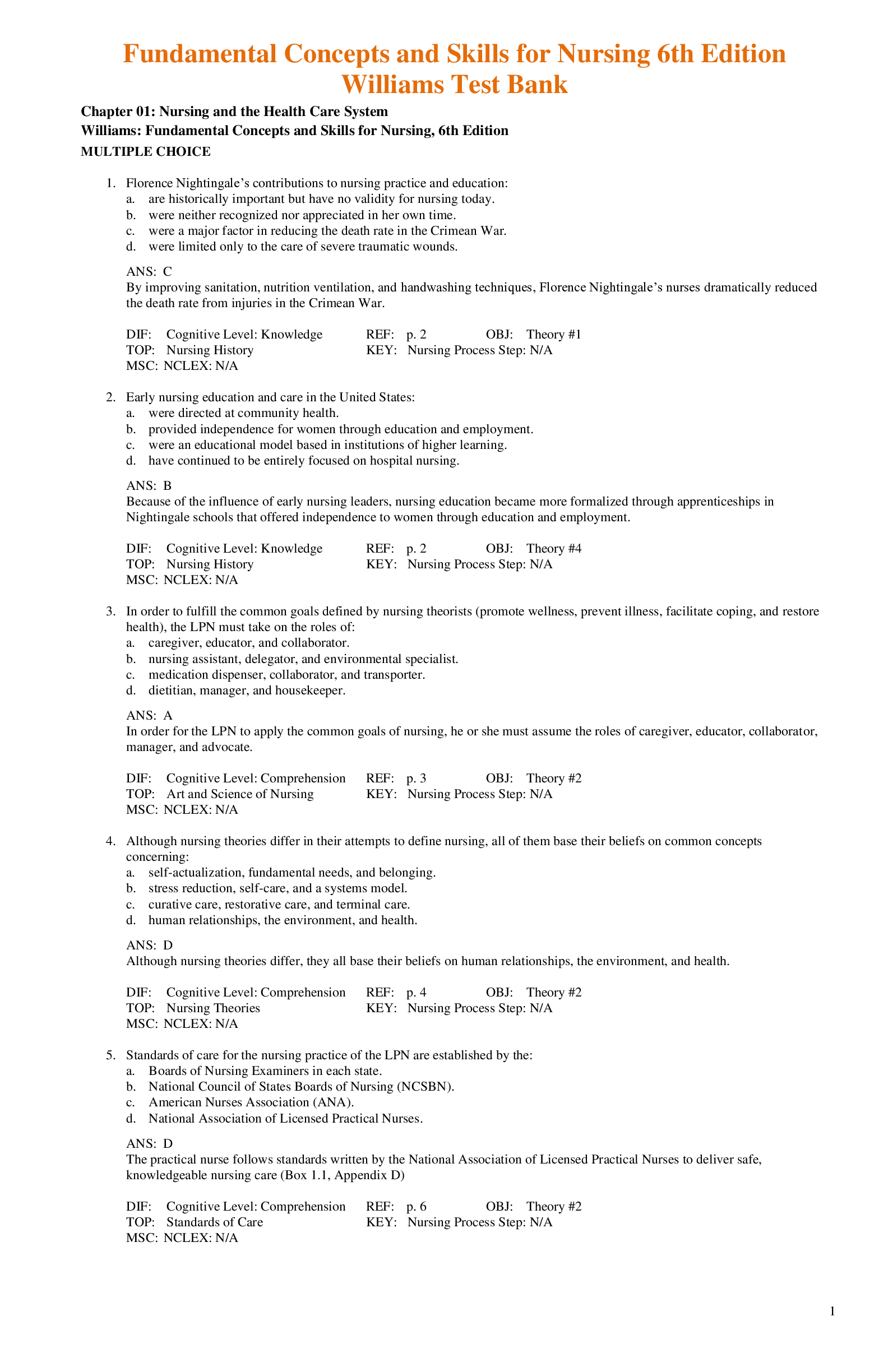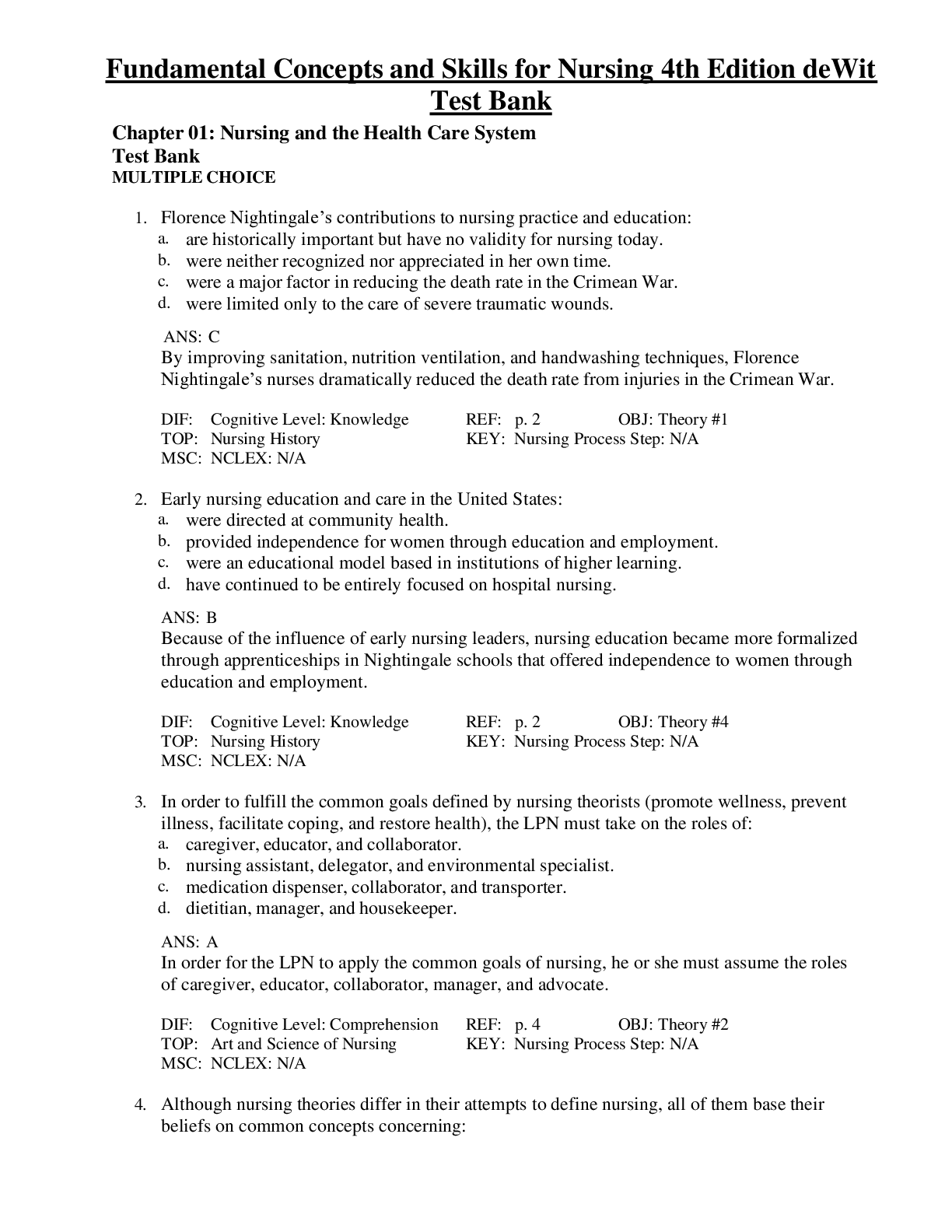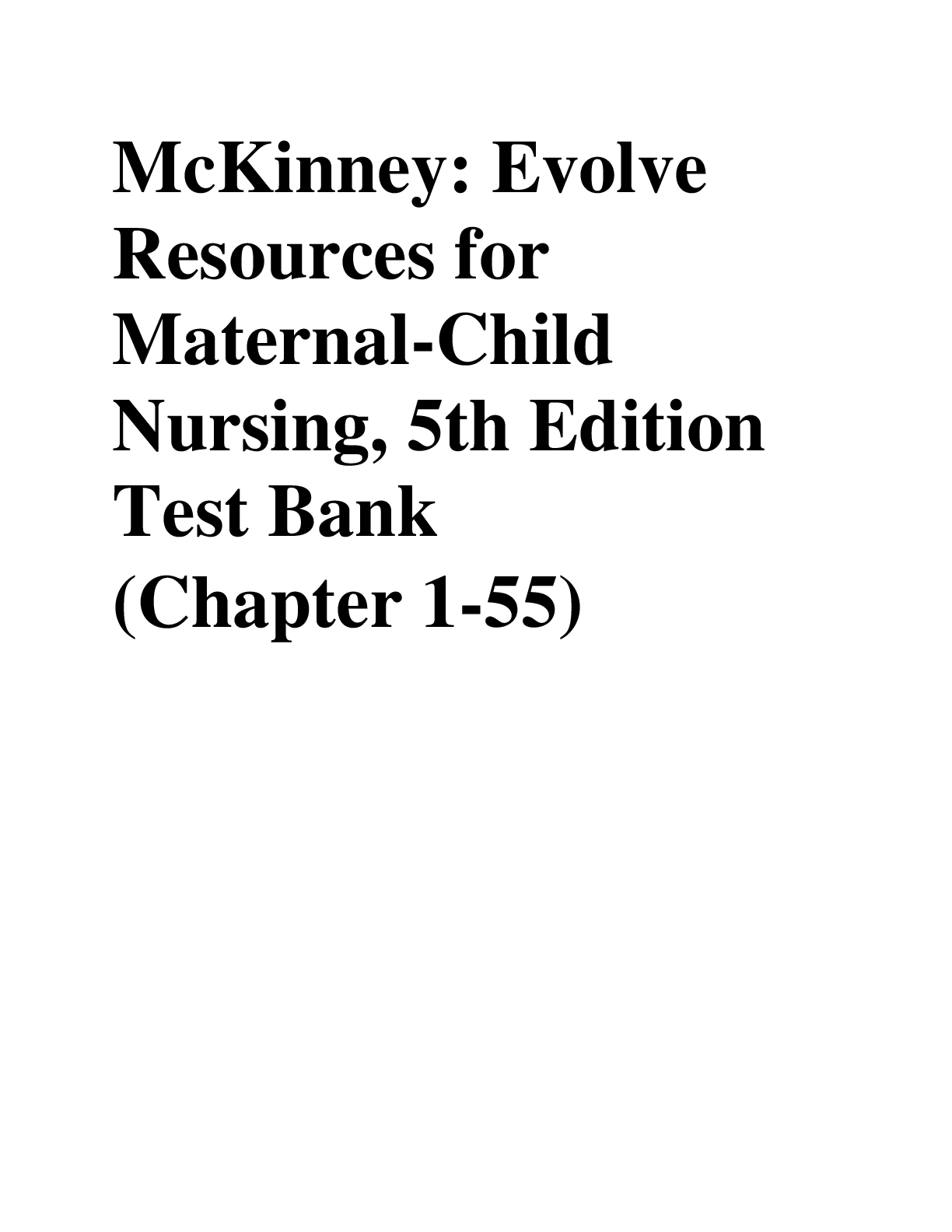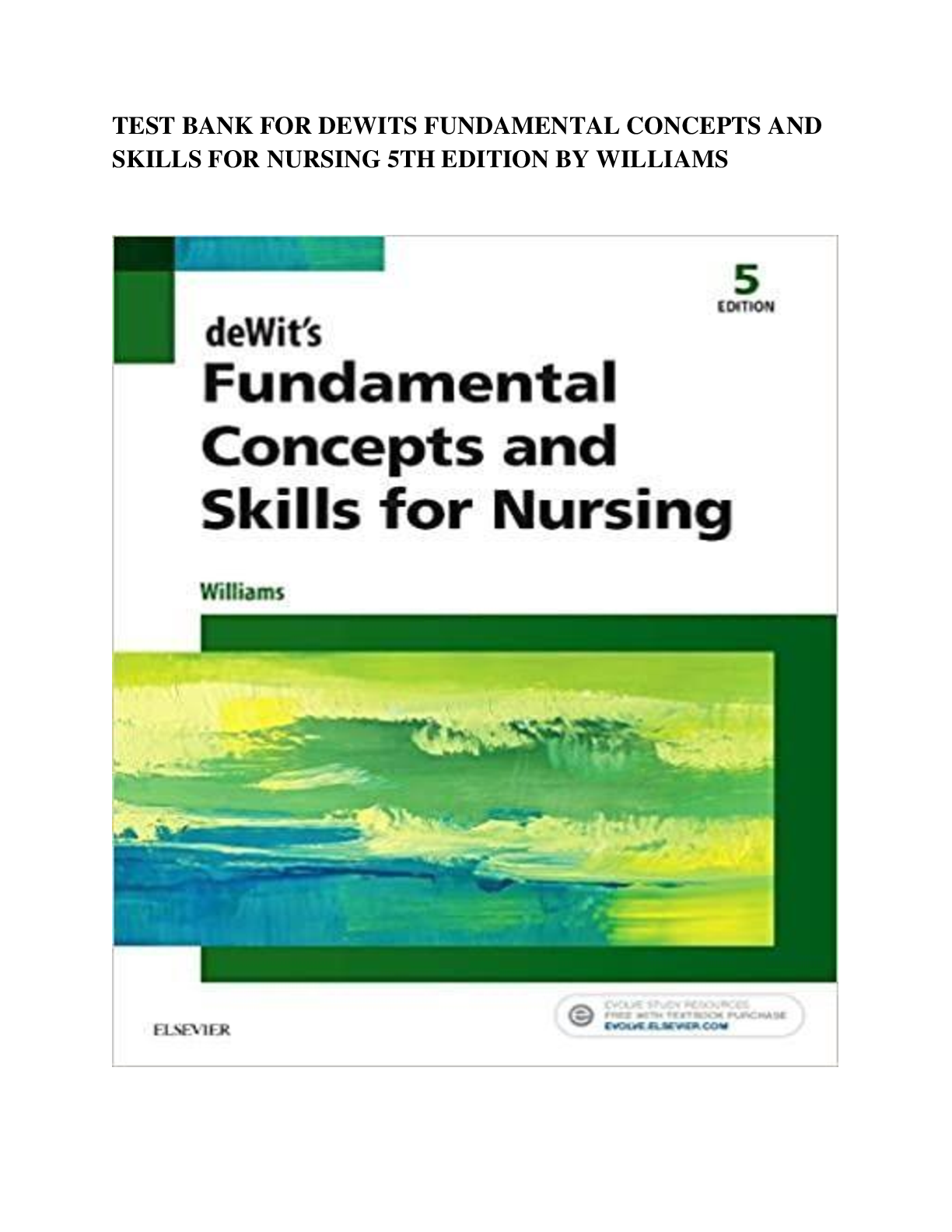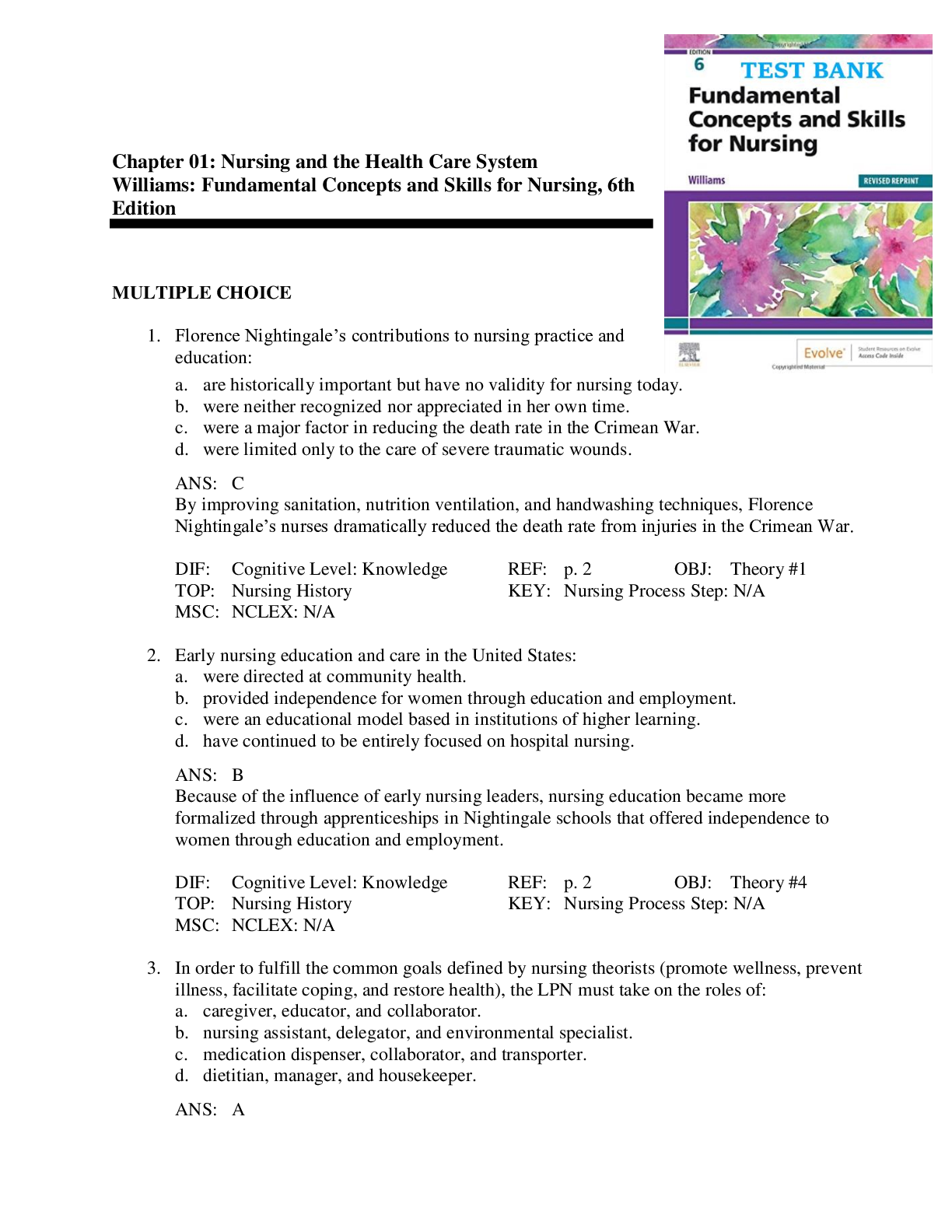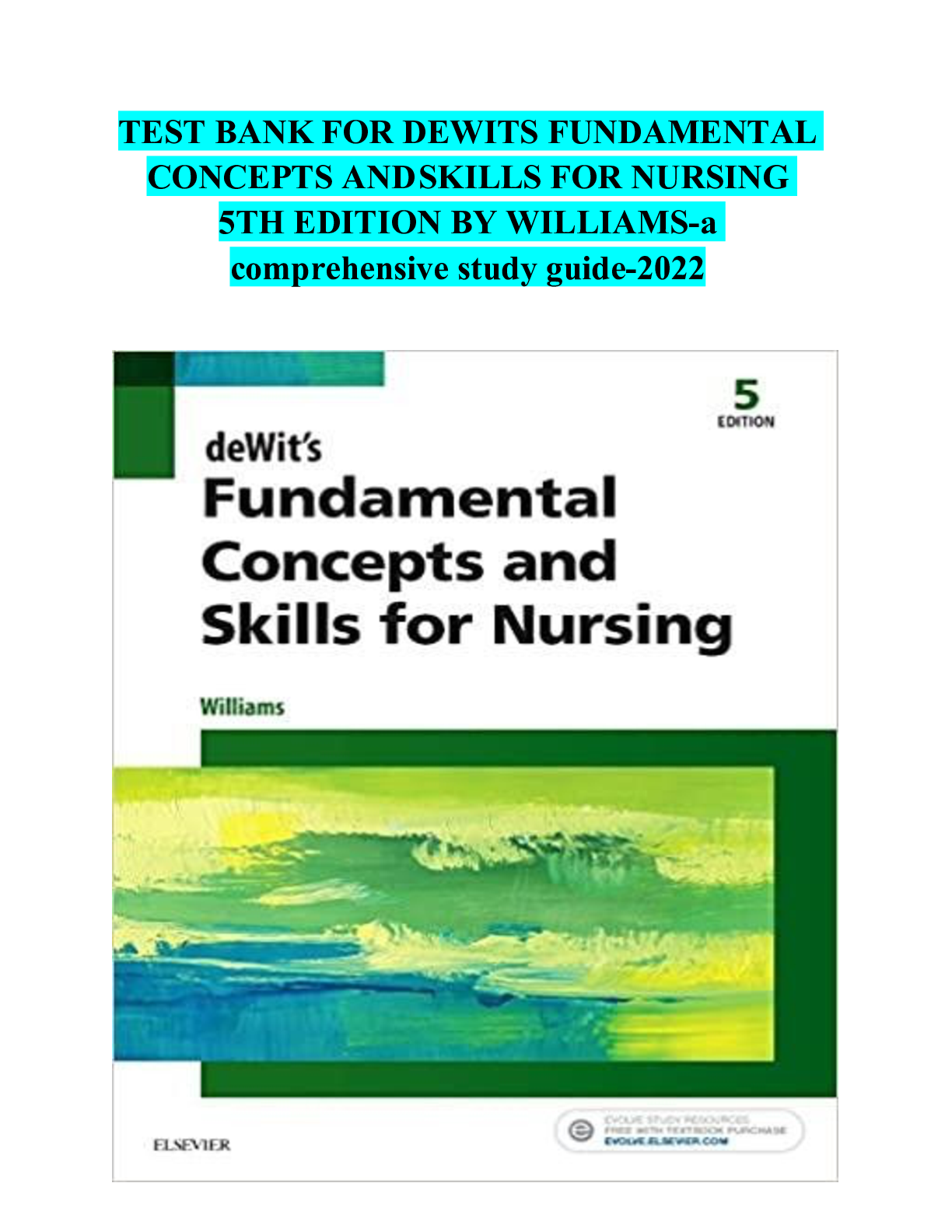Health Care > TEST BANK > Williams deWit's Fundamental Concepts and Skills for Nursing, 5th Edition test bank with answers (All)
Williams deWit's Fundamental Concepts and Skills for Nursing, 5th Edition test bank with answers
Document Content and Description Below
Florence Nightingale‘s contributions to nursing practice and education: a. are historically important but have no validity for nursing today. b. were neither recognized nor appreciated in her own ... time. c. were a major factor in reducing the death rate in the Crimean War. d. were limited only to the care of severe traumatic wounds. ANS: C By improving sanitation, nutrition ventilation, and handwashing techniques, Florence Nightingale‘s nurses dramatically reduced the death rate from injuries in the Crimean War. DIF: Cognitive Level: Knowledge REF: p. 2 OBJ: Theory #1 TOP: Nursing History KEY: Nursing Process Step: N/A MSC: NCLEX: N/A 2. Early nursing education and care in the United States: a. were directed at community health. b. provided independence for women through education and employment. c. were an educational model based in institutions of higher learning. d. have continued to be entirely focused on hospital nursing. ANS: B Because of the influence of early nNuUrRsiSnIgNGleTaBd.eCrOs,Mnursing education became more formalized through apprenticeships in Nightingale schools that offered independence to women through education and employment. DIF: Cognitive Level: Knowledge REF: p. 2 OBJ: Theory #4 TOP: Nursing History KEY: Nursing Process Step: N/A MSC: NCLEX: N/A 3. In order to fulfill the common goals defined by nursing theorists (promote wellness, prevent illness, facilitate coping, and restore health), the LPN must take on the roles of: a. caregiver, educator, and collaborator. b. nursing assistant, delegator, and environmental specialist. c. medication dispenser, collaborator, and transporter. d. dietitian, manager, and housekeeper. ANS: A In order for the LPN to apply the common goals of nursing, he or she must assume the roles of caregiver, educator, collaborator, manager, and advocate. DIF: Cognitive Level: Comprehension REF: p. 3 OBJ: Theory #2 TOP: Art and Science of Nursing KEY: Nursing Process Step: N/A MSC: NCLEX: N/A 4. Although nursing theories differ in their attempts to define nursing, all of them base their beliefs on common concepts concerning: NURSINGTB.COM a. self-actualization, fundamental needs, and belonging. b. stress reduction, self-care, and a systems model. c. curative care, restorative care, and terminal care. d. human relationships, the environment, and health. ANS: D Although nursing theories differ, they all base their beliefs on human relationships, the environment, and health. DIF: Cognitive Level: Comprehension REF: p. 4 OBJ: Theory #2 TOP: Nursing Theories KEY: Nursing Process Step: N/A MSC: NCLEX: N/A 5. Standards of care for the nursing practice of the LPN are established by the: a. Boards of Nursing Examiners in each state. b. National Council of States Boards of Nursing (NCSBN). c. American Nurses Association (ANA). d. National Federation of Licensed Practical Nurses. ANS: D The National Federation of Licensed Practical Nurses modified the standards published by the ANA in 2015 to better fit the role of the LPN. In 2015 the American Nurses Association (ANA) revised the Standards of Nursing Practice which contained 17 standards of national practice of nursing, describing all facets of nursing practice: who, what, when, where, how. DIF: Cognitive Level: Comprehension REF: p. 6 OBJ: Theory #2 TOP: Standards of Care KEY: Nursing Process Step: N/A MSC: NCLEX: N/A 6. The LPN demonstrates an evidence-based practice by: a. using a drug manual to check compatibility of drugs. b. using scientific information to guide decision making. c. using medical history of a patient to direct nursing interventions. d. basing nursing care on advice from an experienced nurse. ANS: B The use of scientific information from high-quality research to guide nursing decisions is reflective of the application of evidence-based practice. DIF: Cognitive Level: Knowledge REF: p. 7 OBJ: Theory #3 TOP: Evidence-Based Practice KEY: Nursing Process Step: N/A MSC: NCLEX: N/A 7. Lillian Wald and Mary Brewster established the Henry Street Settlement Service in New York in 1893 in order to: a. offer a shelter to injured war veterans. b. found a nursing apprenticeship. c. provide health care to poor persons living in tenements. d. offer better housing to low-income families. ANS: C NURSINGTB.COM Henry Street Settlement Service brought the provision of community health care to the poor people living in tenements. DIF: Cognitive Level: Comprehension REF: p. 2 OBJ: Theory #4 TOP: Growth of Nursing KEY: Nursing Process Step: N/A MSC: NCLEX: N/A 8. An educational pathway for an LPN/LVN refers to an LPN/LVN: a. learning on the job and being promoted to a higher level of responsibility. b. moving from a maternity unit to a more complicated surgical unit. c. obtaining additional education to move from one level of nursing to another. d. learning that advancement requires consistent work and commitment. ANS: C By broadening the educational base, an LPN/LVN may advance and build a nursing career. DIF: Cognitive Level: Knowledge REF: p. 7 OBJ: Theory #7 TOP: Nursing Education Pathways KEY: Nursing Process Step: N/A MSC: NCLEX: N/A 9. When diagnosis-related groups (DRGs) were established by Medicare in 1983, the purpose was to: a. put patients with the same diagnosis on the same unit. b. attempt to contain the costs of health care. c. increase the availability of medical care to older adults. d. identify a patient‘s condition more quickly. ANS: B The purpose of instituting DRGs was to contain skyrocketing costs of health care. DIF: Cognitive Level: Knowledge REF: p. 9 OBJ: Theory #10 TOP: Health Care Delivery KEY: Nursing Process Step: N/A MSC: NCLEX: N/A 10. The advent of diagnosis-related groups (DRGs) required that nurses working in health care agencies: a. record supportive documentation to confirm a patient‘s need for care in order to qualify for reimbursement. b. use the DRG rather than their own observations for patient assessment. c. be aware of the specific drugs related to the diagnosis. d. acquire cross-training to make staffing more flexible. ANS: A DRGs required that nurses provide more supportive documentation of their assessments and identified patient‘s needs to qualify the facility for Medicare reimbursement. Observant assessment might also indicate another DRG classification and consequently more reimbursement for the facility. DIF: Cognitive Level: Comprehension [Show More]
Last updated: 1 year ago
Preview 1 out of 462 pages
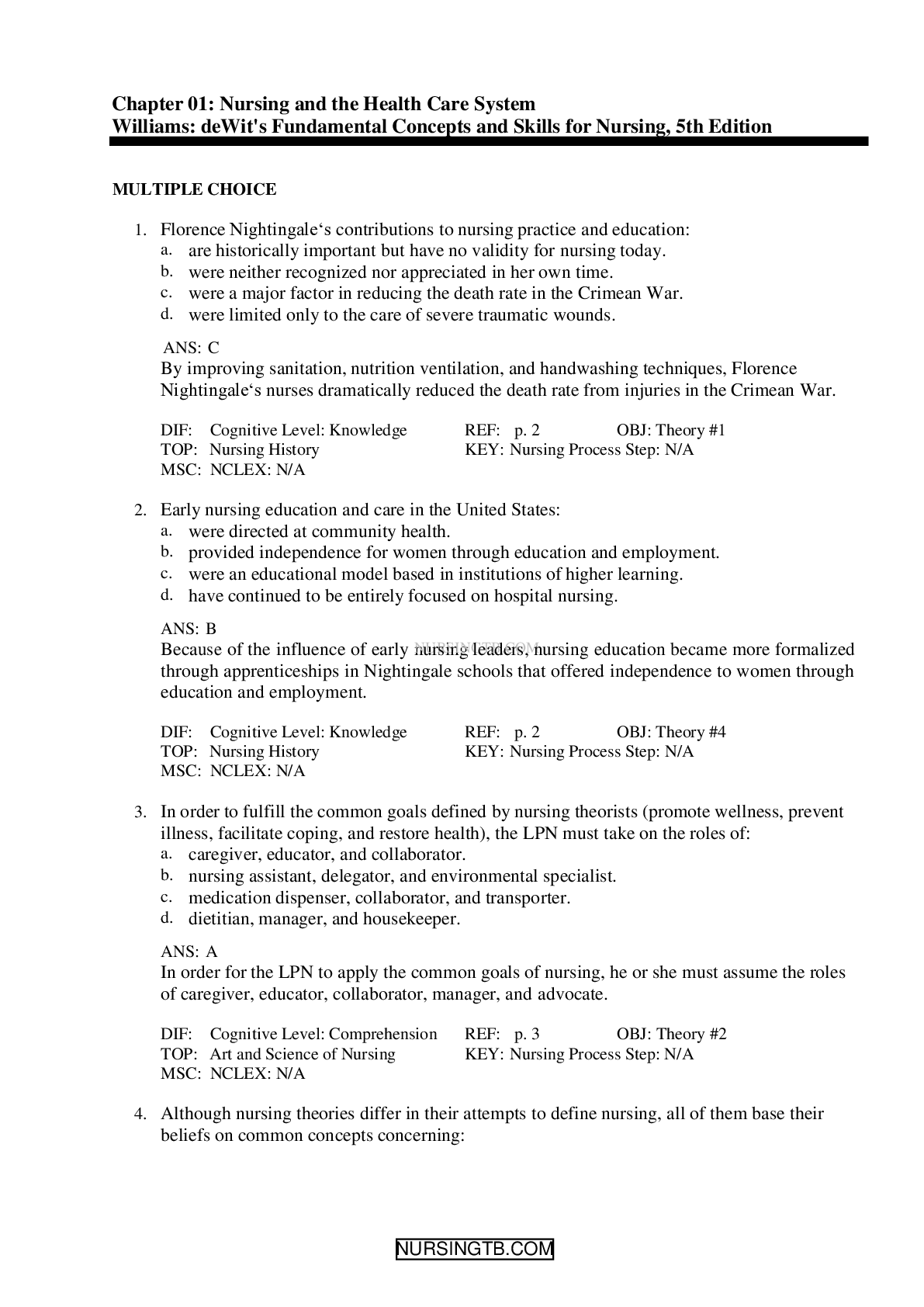
Reviews( 0 )
Document information
Connected school, study & course
About the document
Uploaded On
Oct 27, 2021
Number of pages
462
Written in
Additional information
This document has been written for:
Uploaded
Oct 27, 2021
Downloads
0
Views
40


